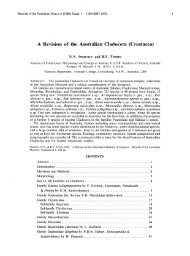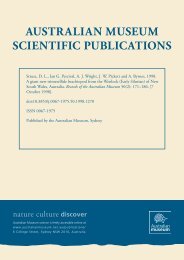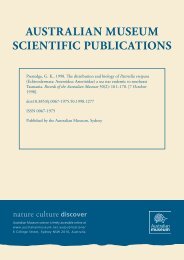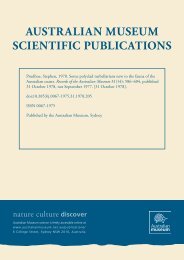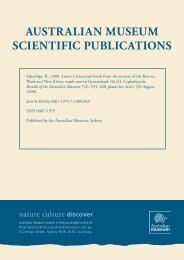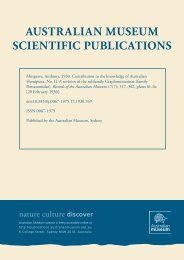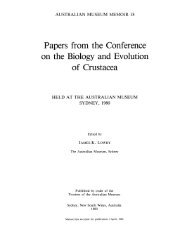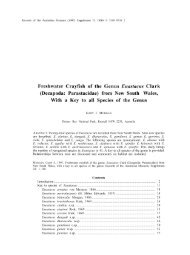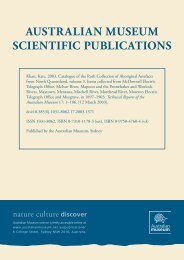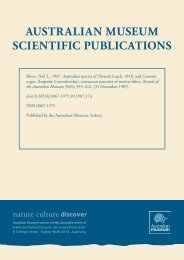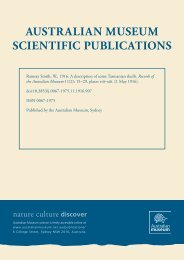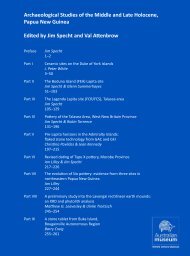Complete work (1212kb PDF) - Australian Museum
Complete work (1212kb PDF) - Australian Museum
Complete work (1212kb PDF) - Australian Museum
You also want an ePaper? Increase the reach of your titles
YUMPU automatically turns print PDFs into web optimized ePapers that Google loves.
CRINOID INTER-RELATIONSHIPS 123<br />
similar to that ofPhrynocrinus, prompting him to refer the genus to the Phrynocrinidae although<br />
he said that the upper part of the stalk resembled that ofRhizocrinus (now Democrinus) weberi and<br />
the calyx is almost perfectly cylindrical with extraordinarily long radials but a basal ring no<br />
higher than the discoidal uppermost columnal just below it (see A. M. Clark, 1973, Fig. 6h). The<br />
arms are unknown.<br />
A fourth genus - Porphyrocrinus - has also been referred to the family Phrynocrinidae,<br />
after considerable deliberation by GisIen (1925), because the type-species, P. verrucosus from<br />
Indonesia, has simple arms, proximally flanged and concealing the tegmen, the calyx is almost<br />
cylindrical and the proximal columnals are discoidal. The stalk attachment is unknown.<br />
Consequently there is very little superficial resemblance to. Phrynocrinus, though more to<br />
Naumachocrinus. However, in 1973 I described a similar species from the SW Indian Ocean,<br />
Porphyrocrinus polyarthra, from a specimen retaining the distal part of the stalk, showing that<br />
attachment is by a lobed terminal expanded plate. Even so, the anomalies between<br />
Porphyrocrinus and N aumachocrinus, on the one hand, and Phrynocrinus on the other, seemed to<br />
me so great that I proposed a third family, Porphyrocrinidae, intermediate between the two<br />
others, characterized by the stalk attachment of the Phrynocrinidae and the calyx form of the<br />
Bathycrinidae.<br />
Subsequently, two factors affecting the validity of this third family and perhaps even of the<br />
Phrynocrinidae, have become evident.<br />
Recently both Roux and I have independently found a new bourgueticrinid which he<br />
described as Porphyrocrinus thalassae in 1977. Smaller specimens of this species (upper stalk<br />
diameter c.3 mm) have simple arms but the larger ones (s.d. c.4 mm) have the first pinnule, on<br />
the right side of the eighth brachial (Brs) modified into a secondary arm and may also have the<br />
first pinnule of the left side (on BfI 0) similarly modified, converting these two ossicles into rather<br />
lop-sided axillaries. Possibly at a larger size still the secondary arms achieve equality with the<br />
primary ones and adopt a plane tangential to the vertical axis instead of being inclined obliquely<br />
like the pinnules; the axillaries would then become more nearly symmetrical. Since the<br />
holotypes of the other species of Porphyrocrinus were smaller, it is not unlikely that they too may<br />
show a similar augmentation in arm number with growth.<br />
Secondly, re-examination of the type material of Democrinus brevis, brought home to me in<br />
1977 the great variation in stalk attachment shown by different species of undoubted<br />
Bathycrinidae, D. brevis showing expanded terminal plates in contrast to both D. parfaiti, the<br />
type-species of Democrinus, and some West Indian specimens which I have attributed to D.<br />
conifer, which consistently have slender branching rhizoids terminating the stalk. Macurda (in<br />
Meyer, Messing and Macurda, 1978) believes that D. brevis and conifer intergrade. Also<br />
McKnight (1977) has described a bathycrinid stalk from the Kermadec Islands which<br />
terminates in both an expanded plate and rhizoids. Gislen's 1927 diagnosis of the Bathycrinidae<br />
as having stalks attached by rhizoids needs modification. As indicated in Table 1, in about a<br />
third of the nominal species of Bathycrinidae the distal part of the stalk is unknown.<br />
Hopefully, the current increase in the amount of deep-water biological collecting and the<br />
number of specialists interested in these animals may soon result in some degree of clarification<br />
of the inter-relationships of these recent Bourgueticrinida.




